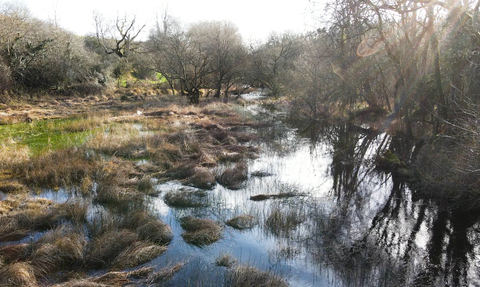
Wetland - Billy Heaney
Wetlands
Teeming with invertebrates, rich in plants and a haven for mammals, wetlands offer an unforgettable experience. These beautiful areas are a vital part of our natural world – the lives of animals, plants and people depend on their health.
Wildlife-rich wetlands
The rain-drenched lands of the UK offer perfect conditions for the formation of wetlands. These places where water and dry land meet are home to a wide range of species, from dragonflies and damselflies, to wading curlew and snipe; from carnivorous plants to flitting butterflies. Wetlands are fantastic places to spot a huge variety of birds, so make sure that you take your binoculars along with you.
What is peat?
Most wetlands are peat-forming. When the ground is too wet for vegetation to decompose, a dark, organic matter called peat forms. This very slow growing material is an extremely important habitat for plants, such as sundew and marsh violet, which in turn support invertebrate and bird populations.
As well as providing a valuable habitat for wildlife, peatlands are ‘carbon sinks’, removing carbon from the atmosphere and storing it.
They’re also vital forms of flood defence and water purification. Peat acts as a sponge, absorbing rain, snowmelt and mist, then gradually releasing it back. This regulates the flow of rivers, reducing flooding after storms and maintaining flow in dry weather. Wetlands filter water too, improving the quality.
How have wetlands traditionally been managed?
Many wetlands are dynamic and if left alone, over long time spans, would develop into a different wetland type, or into woodland. However, the traditional management of wetlands stopped this process, allowing species that live in these areas to flourish and thrive. This included harvesting sedge and reed for thatch, and cutting and drying peat for fuel.
Threats to wetlands
In more recent years, the traditional management of wetlands has been replaced by industrial scale use. Raised bogs especially have been (and in some places still are being) destroyed or degraded through industrial peat-cutting for fuel or use in gardens.
Wetlands vary greatly. Some wetlands are very extensive, such as blanket bog, while others are naturally more localised, such as upland spring and flush. In other cases, particularly in the lowlands, drainage and industrial-scale peat-cutting has reduced or destroyed many wetlands. Areas of raised bog, fen and reedbed are now a fraction of what they once were.
Some types of wetlands are now legally protected, but many are still not in good condition.
How you can help
The most important thing you can do to help wetlands is to buy peat-free products for your garden, including not buying any plants grown in peat. Ask for peat-free compost at your garden centre. You could also try making your own compost!
Creating a small bog garden provides a tiny haven for the unusual life that likes its feet wet. On a larger scale wetland creation can be found either as part of an extension to an existing marsh, bog or fen, part of a scheme to enhance the farmed landscape or an element in a Sustainable Drainage scheme as an integrated part of a new development. Reedbeds have been long used in sewage treatment works to put the final polish on treated water. Constructed wetlands are designed to help treat farmyard run-off and invariably teem with dragonfly guardians in the years after first filling. New wetlands very quickly form new havens for spectacular wildlife and are worthwhile in every way.
The Wildlife Trusts campaign to raise awareness of the value of wetland habitats and the threats that they face. We work to prevent further loss of our lowland raised bogs by looking after many areas as nature reserves. We are currently restoring areas that have deteriorated and working with landowners and farmers to promote wildlife-friendly practices on their wetland areas.
